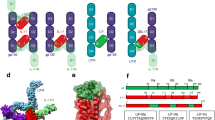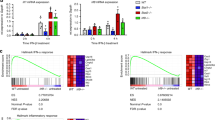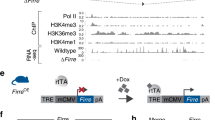Abstract
IL-22 is a newly identified member of the interferon/IL-10 family. In humans, IL-22 signals through a heteroduplex receptor consisting of IL-22R and CRF2–4/IL-10Rβ. To investigate the physiological function of IL-22 and IL-22R, we isolated a cDNA encoding the mouse IL-22R, which has been a missing component of the functional receptor complex for mouse IL-22. Subsequently, we identified the genomic sequence of the mouse IL-22R gene by a database search. The gene consists of about 24 kb and is split into seven exons. Interestingly, intron 2 begins with a GC dinucleotide instead of the consensus GT, although otherwise the overall structure of the mouse IL-22R gene is strikingly similar to its human counterpart. The gene was mapped to mouse chromosome 4 in the region syntenic to the human IL-22R gene locus. In normal mice, IL-22R mRNA is detected at very low levels in restricted organs such as the kidney, liver, and lung. However, upon lipopolysaccharide stimulation, IL-22R mRNA expression is highly upregulated in the liver, in contrast to CRF2–4, which is expressed constitutively in a variety of tissues. Thus, the expression of the functional IL-22 receptor in the liver is regulated at the gene transcription level.
This is a preview of subscription content, access via your institution
Access options
Subscribe to this journal
Receive 6 digital issues and online access to articles
$119.00 per year
only $19.83 per issue
Buy this article
- Purchase on Springer Link
- Instant access to full article PDF
Prices may be subject to local taxes which are calculated during checkout




Similar content being viewed by others
References
Fickenscher H, Hor S, Kupers H et al. The interleukin-10 family of cytokines. Trends Immunol 2002; 23: 89–96.
Gallagher G, Dickensheets H, Eskdale J et al. Cloning, expression and initial characterization of interleukin-19 (IL- 19), a novel homologue of human interleukin-10 (IL-10). Genes Immun 2000; 1: 442–450.
Blumberg H, Conklin D, Xu WF et al. Inerleukin 20: discovery, receptor identification, and role in epidermal function. Cell 2001; 104: 9–19.
Dumoutier L, Louahed J, Renauld JC . Cloning and characterization of IL-10-related T cell-derived inducible factor (IL-TIF), a novel cytokine structurally related to IL-10 and inducible by IL-9. J Immunol 2000; 164: 1814–1819.
Dumoutier L, Van Roost E, Ameye G, Michaux L, Renauld JC . IL-TIF/IL-22: genomic organization and mapping of the human and mouse genes. Genes Immun 2000; 1: 488–494.
Jiang H, Lin JJ, Su ZZ, Goldstein NI, Fisher PB . Subtraction hybridization identifies a novel melanoma differentiation associated gene, mda-7, modulated during human melanoma differentiation, growth and progression. Oncogene 1995; 11: 2477–2486.
Knappe A, Hor S, Wittmann S, Fickenscher H . Induction of a novel cellular homolog of interleukin-10, AK155, by transformation of T lymphocytes with herpesvirus saimiri. J Virol 2000; 74: 3881–3887.
Dumoutier L, Van Roost E, Colau D, Renauld JC . Human interleukin-10-related T cell-derived inducible factor: molecular cloning and functional characterization as a hepatocyte-stimulating factor. Proc Natl Acad Sci USA 2000; 97: 10144–10149.
Aggarwal S, Xie MH, Maruoka M, Foster J, Gurney AL . Acinar cells of the pancreas are a target of interleukin-22. J Interferon Cytokine Res 2001; 21: 1047–1053.
Xie MH, Aggarwal S, Ho WH et al. Interleukin (IL)-22, a novel human cytokine that signals through the interferon receptor-related proteins CRF2–4 and IL-22R. J Biol Chem 2000; 275: 31335–31339.
Kotenko SV, Izotova LS, Mirochnitchenko OV et al. Identification of the functional interleukin-22 (IL-22) receptor complex: the IL-10R2 chain (IL-10Rbeta) is a common chain of both the IL-10 and IL-22 (IL-10-related T cell-derived inducible factor, IL-TIF) receptor complexes. J Biol Chem 2001; 276: 2725–2732.
Dumoutier L, Lejeune D, Colau D, Renauld JC . Cloning and characterization of IL-22 binding protein a natural, antagonist of IL-10-related T cell-derived inducible factor/IL-22. J Immunol 2001; 166: 7090–7095.
Kotenko SV, Izotova LS, Mirochnitchenko OV et al. Identification, cloning, and characterization of a novel soluble receptor that binds IL-22 and neutralizes its activity. J Immunol 2001; 166: 7096–7103.
Xu W, Presnell SR, Parrish-Novak J et al. A soluble class II cytokine receptor, IL-22RA2, is a naturally occurring IL-22 antagonist. Proc Natl Acad Sci USA 2001; 98: 9511–9516.
Gruenberg BH, Schoenemeyer A, Weiss B et al. A novel, soluble homologue of the human IL-10 receptor with preferential expression in placenta. Genes Immun 2001; 2: 329–334.
Wang M, Tan Z, Zhang R, Kotenko SV, Liang P . Interleukin 24 (MDA-7/MOB-5) signals through two heterodimeric receptors, IL-22R1/IL-20R2 and IL-20R1/IL-20R2. J Biol Chem 2002; 277: 7341–7347.
Gerhartz C, Heesel B, Sasse J et al. Differential activation of acute phase response factor/STAT3 and STAT1 via the cytoplasmic domain of the interleukin 6 signal transducer gp130, I. Definition of a novel phosphotyrosine motif mediating STAT1 activation. J Biol Chem 1996; 271: 12991–12998.
Engel JD, Beug H, LaVail JH et al. cis and trans regulation of tissue-specific transcription. J Cell Sci 1992; 16 (Suppl): 21–31.
Quandt K, Frech K, Karas H, Wingender E, Werner T . MatInd and MatInspector: new fast and versatile tools for detection of consensus matches in nucleotide sequence data. Nucleic Acids Res 1995; 23:4878–4884.
Murai K, Murakami H, Nagata S . Myeloid-specific transcriptional activation by murine myeloid zinc- finger protein 2. Proc Natl Acad Sci USA 1998; 95: 3461–3466.
Sompayrac LM, Danna KJ . Efficient infection of monkey cells with DNA of simian virus 40. Proc Natl Acad Sci USA 1981; 78: 7575–7578.
Suda T, Okazaki T, Naito Y et al. Expression of the Fas ligand in cells of T cell. 20 lineage. J Immunol 1995; 154: 3806–3813.
Acknowledgements
We thank Ms I Hashitani for secretarial and technical assistance. This study was supported in part by the Special Coordination Funds for Promoting Science and Technology, and Grants-in-Aid for Scientific Research on Priority Areas (Diagnosis and Treatment of Cancer) from the Ministry of Education, Culture, Sports, Science and Technology of the Japanese Government.
Author information
Authors and Affiliations
Corresponding author
Rights and permissions
About this article
Cite this article
Tachiiri, A., Imamura, R., Wang, Y. et al. Genomic structure and inducible expression of the IL-22 receptor α chain in mice. Genes Immun 4, 153–159 (2003). https://doi.org/10.1038/sj.gene.6363934
Received:
Revised:
Accepted:
Published:
Issue Date:
DOI: https://doi.org/10.1038/sj.gene.6363934
Keywords
This article is cited by
-
Role of IL-22 in intestinal microenvironment and potential targeted therapy through diet
Immunologic Research (2023)
-
Interleukin-22 ameliorated acetaminophen-induced kidney injury by inhibiting mitochondrial dysfunction and inflammatory responses
Applied Microbiology and Biotechnology (2020)
-
IL-22Ra1 is induced during influenza infection by direct and indirect TLR3 induction of STAT1
Respiratory Research (2019)
-
IL-22 is rapidly induced by Pathogen Recognition Receptors Stimulation in Bone-Marrow-derived Dendritic Cells in the Absence of IL-23
Scientific Reports (2016)
-
The Effects of IL-22 on the Inflammatory Mediator Production, Proliferation, and Barrier Function of HUVECs
Inflammation (2016)



